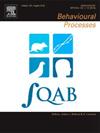Nuanced effects of relative body size on social motivation in a highly gregarious catfish
IF 1.5
4区 生物学
Q4 BEHAVIORAL SCIENCES
引用次数: 0
Abstract
Many factors affect the social strategies that individuals adopt, including environmental parameters, developmental stage, and familiarity, but these are typically investigated in isolation. Understanding how social strategies are shaped by various potentially interacting factors is fundamental to understanding social evolution. We used highly gregarious catfish from the subfamily Corydoradinae to assess how familiarity, environmental cues, and relative body size impact coordination and communication within pairs of fish. Unlike many other model systems, Corydoradinae catfish exhibit clear inter-individual social overtures (termed ‘nudges’) that serve as an easily quantifiable measure of social motivation. Our results show that relative size was a significant predictor of individual nudges across all factor combinations, with smaller individuals nudging at higher rates than their larger partner. However, this effect was most pronounced among socially unfamiliar individuals that shared an environmental background (i.e. diet), but was largely absent when fish were familiar with one another or came from different environmental backgrounds. Cories thus appear to differ from the common behavioral model system three-spined sticklebacks in that familiarity and shared environmental background do not have the same effect on social preferences. Together these results demonstrate that relative body size is important in social interactions of these fish, but that other factors alter its impact. We thus show that individual characteristics affect social motivation in complex ways that likely influence group coordination and composition. This may explain the persistence of the highly heterogeneous groups these fish form in the wild.
在高度群居的鲶鱼中,相对体型对社会动机的细微影响
许多因素影响个体采取的社会策略,包括环境参数、发展阶段和熟悉程度,但这些通常是孤立的研究。了解社会策略是如何由各种潜在的相互作用因素形成的,是理解社会进化的基础。我们使用高度群居的鲶鱼来评估熟悉度、环境线索和相对体型对鱼对间协调和交流的影响。与许多其他模型系统不同,长尾鲶鱼表现出明确的个体间社会示好(称为“轻推”),这是一种容易量化的社会动机衡量标准。我们的研究结果表明,在所有因素组合中,相对体型是个体轻推的重要预测因素,体型较小的个体轻推的频率高于体型较大的伴侣。然而,这种影响在社会上不熟悉的个体中最为明显,这些个体共享环境背景(即饮食),但当鱼彼此熟悉或来自不同的环境背景时,这种影响在很大程度上不存在。因此,在熟悉度和共同的环境背景对社会偏好的影响上,三刺鱼似乎与常见的行为模型系统三刺鱼有所不同。总之,这些结果表明,相对体型在这些鱼的社会互动中很重要,但其他因素会改变其影响。因此,我们表明个体特征以复杂的方式影响社会动机,可能影响群体的协调和组成。这也许可以解释这些鱼在野外形成的高度异质群体的持久性。
本文章由计算机程序翻译,如有差异,请以英文原文为准。
求助全文
约1分钟内获得全文
求助全文
来源期刊

Behavioural Processes
生物-动物学
CiteScore
2.70
自引率
7.70%
发文量
144
审稿时长
4-8 weeks
期刊介绍:
Behavioural Processes is dedicated to the publication of high-quality original research on animal behaviour from any theoretical perspective. It welcomes contributions that consider animal behaviour from behavioural analytic, cognitive, ethological, ecological and evolutionary points of view. This list is not intended to be exhaustive, and papers that integrate theory and methodology across disciplines are particularly welcome.
 求助内容:
求助内容: 应助结果提醒方式:
应助结果提醒方式:


